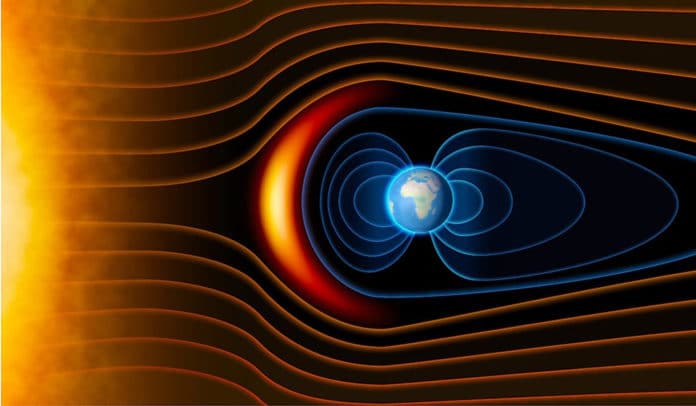A study by the University of Liverpool supports the theory that Earth’s magnetic field is cyclical and weakens every 200 million years. This new study fills in an important time gap in the previous study by the same scientists. One of the limitations at the time was the lack of reliable field strength data available before 300 million years ago.
Scientists performed thermal, and microwave paleomagnetic analysis on rock samples from ancient lava flows in Eastern Scotland to measure the earth’s magnetic field strength during crucial periods with almost no pre-existing, reliable data. They analyzed the reliability of all of the measurements from samples from 200 to 500 million years ago, collected over the last ~80 years.
They found that between 332 and 416 million years ago, the strength of the geomagnetic field preserved in these rocks was less than a quarter of what it is today. Also, it appears similar to a previously identified period of low magnetic field strength that started around 120 million years ago.
Liverpool palaeomagnetist and lead author of the paper, Dr. Louise Hawkins, said: “This comprehensive magnetic analysis of the Strathmore and Kinghorn lava flows was key for filling in the period leading up the Kiman Superchron, a period where the geomagnetic poles are stable and do not flip for about 50 million years.”
“This dataset complements other studies we have worked on over the last few years, alongside our colleagues in Moscow and Alberta, that fit between the ages of these two locations.”
“Our findings, when considered alongside the existing datasets, support the existence of an approximately 200-million-year long cycle in the strength of the Earth’s magnetic field related to deep Earth processes. As almost all of our evidence for processes within the Earth’s interior is being constantly destroyed by plate tectonics, the preservation of this signal for deep inside the Earth is exceedingly valuable as one of the few constraints we have.”
“Our findings also provide further support that a weak magnetic field is associated with pole reversals, while the field is generally strong during a Superchron, which is important as it has proved nearly impossible to improve the reversal record before ~300 million years ago.”
Journal Reference:
- Louise M. A. Hawkins et al. Intensity of the Earth’s magnetic field: Evidence for a Mid-Paleozoic dipole low. DOI: 10.1073/pnas.2017342118
